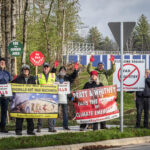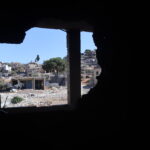In May 1718, Captain Blackbeard and his pirates occupied the port of Charleston, South Carolina, with the infamous ship Queen Anne’s Revenge for a week. During this occupation, they seized ships, detained the crew and passengers, and made demands of the colonial government of South Carolina. The occupation ended when the government met Blackbeard’s demands, providing him with various supplies, including a chest of medicine, which were fundamental to him and his crew.
In March 2022, Russian forces seized the Zaporizhzhia Nuclear Power Plant and detained the Ukrainian operators. Russia started using the plant as a military base for its ongoing invasion of Ukraine. The plant has been under Russian occupation ever since, raising serious nuclear safety and security concerns. And it’s unclear when the Russian occupation will end.
Though separated by time and context, these two events share intriguing similarities, offering valuable insights into the concept of piracy: The weaponization of strategic assets to assert dominance and achieve strategic objectives. While Blackbeard’s blockade aimed to extract resources and exert influence, the Russian occupation of the Zaporizhzhia Nuclear Power Plant aimed to secure a military and geopolitical advantage.
In this context, the occupation of the plant exemplifies the concept of nuclear piracy — a term that might be loosely defined as the illicit acquisition, manipulation, and exploitation of nuclear assets for strategic purposes. This modern-day form of piracy presents distinctive challenges, where a state actor exploits the inherent capabilities of nuclear facilities to advance its strategic objectives.
Not “Nuclear Terrorism”
Before discussing ways to mitigate the new challenge, it’s important to note that various actors describe the Russian occupation of the plant using different terms. For example, Ukrainian and some Western scholars prefer “nuclear terrorism” to describe the occupation. In this context, President Volodymyr Zelenskyy warned about a possible “terrorist attack” on the plant, resulting in radiation leakage beyond Ukrainian borders.
However, nuclear terrorism, by definition, does not apply to this specific occupation. Nuclear terrorism can be defined as “the unauthorized use or attempted use of nuclear explosive devices, use or attempted use of nuclear materials, or attacks or attempted attacks on nuclear facilities and installations for extortionate purposes.” The International Convention for the Suppression of Acts of Nuclear Terrorism of 2005, which currently has 115 signatories, criminalizes acts of nuclear terrorism and seeks to promote international cooperation to punish such acts. Still, it emphasizes that the actions of military forces are regulated by distinct rules of international law rather than the convention.
Furthermore, as a term, “nuclear terrorism” fails to reflect reality by not addressing the ongoing occupation that endangers the three main functions of nuclear safety systems: containment, control, and cooling. There is no doubt that the use of “nuclear terrorism” in this context indicates the psychological and emotional implications of a highly possible post-nuclear incident at the side because Russia is not only violating the rules-based nuclear order but also vandalizing it. Hence, intentional sabotage is considered the greatest threat.
Just as Blackbeard weaponized the port to further his interests, the Russian occupation of the Zaporizhzhia Nuclear Power Plant transformed the plant into a tool of coercion. These parallel acts of control and manipulation raise alarm bells and demand proactive policy responses.
Russia and Ukraine both accuse each other of a potential attack on the plant regardless of the labels. In case of a nuclear incident, the potential radiological consequences would be beyond the national borders of the two states based on the level of destruction and weather. Yet, it is safe to state that the potential consequences would include death and illness resulting from radiation release, contamination of agricultural land and water supplies, disruption of transportation and communication networks, and damage to the credibility of nuclear power. Many articles focus on these potential consequences, but this one will concentrate on how to prevent them.
Just as Blackbeard weaponized the port to further his interests, the Russian occupation of the Zaporizhzhia Nuclear Power Plant transformed the plant into a tool of coercion. These parallel acts of control and manipulation raise alarm bells and demand proactive policy responses.
Preventing Nuclear Piracy
For the first time in history, a war is occurring in a nuclear powered state with advanced nuclear infrastructure and operational facilities. Additionally, the plant has been occupied, and the operating personnel have been detained and forced to work under Russian forces’ control. This indicates the need to go beyond international conventions when it comes to the management of nuclear power plants during wartime.
Preventing a nuclear incident would require practical solutions, which we did not need before as there were no such cases. In the past, when a nuclear facility was attacked by another state, such as in Iran, Iraq, and Syria, the nuclear facilities were not even operational, and the attacks consisted of only airstrikes in an attempt to prevent possible nuclear proliferation. The Russian takeover of the Zaporizhzhia Nuclear Power Plant is a unique case. One of the operational solutions is the demilitarization of the plant, which has been called by the UN and the International Atomic Energy Agency (IAEA). Such a zone would entail the complete removal of all military personnel and equipment from the vicinity of the facility. However, in March 2023, the IAEA announced that converting the Zaporizhzhia Nuclear Power Plant into a demilitarized zone is no longer considered a viable option due to Russia’s resistance.
One other practical solution is to establish a nuclear safety and security protection zone around the plant. As military conflict poses a constant threat to nuclear safety and security that may lead to radiological consequences with significant implications, the establishment of such a zone might prevent a nuclear incident or accident. This zone might also help avoid any further damage to the plant and ensure its physical integrity. Additionally, it would alleviate the psychological pressure on operating personnel, which is believed to negatively impact their operating capabilities. Despite the IAEA’s continuous efforts and Director General Rafael Grossi’s personal commitment, the zone has not been established due to the refusal of the Russian side to agree on operational conditions.
Complementary to these offered practical solutions is to grant the IAEA full access to inspections. In August 2022, Grossi led the IAEA Support and Assistance Mission to Zaporizhzhia, after which the IAEA established a continuous presence in the plant to ensure safety and security. However, the IAEA team has limited access and requested further access to all parts of the plant to ensure there are no explosive devices that might compromise the safety and security of the plant. This became more important after the detection of mines in July 2023 within a buffer zone positioned between the internal and external perimeter barriers of the site.
Russia’s occupation of the Zaporizhzhia Nuclear Power Plant is an example of nuclear piracy. It needs to be addressed with urgency as the plant is on the verge of a nuclear accident. While there is no easy way to predict the extent of contamination in the event of an intentional nuclear accident, the psychological effects could be devastating. We must not let nuclear pirates dictate the terms, nor should we reduce the Zaporizhzhia Nuclear Power Plant to merely a chest of medicine.














